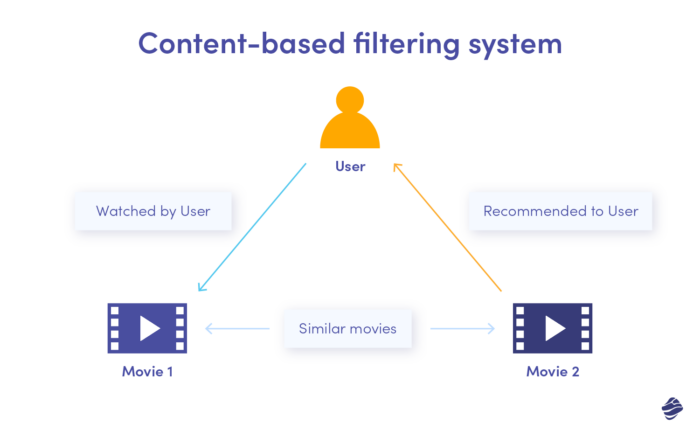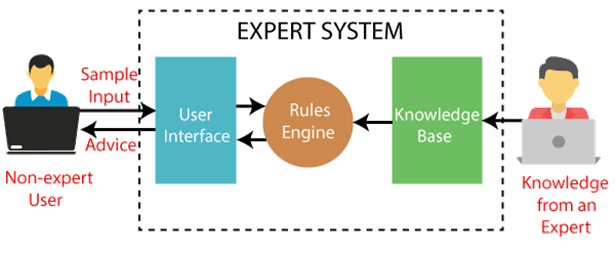How Recommendation Systems Rule the Internet: From TikTok to Tinder, What’s the Tech Used?
 Aakashi Jaiswal
Aakashi Jaiswal
Recommendation systems have become the invisible engine powering much of the modern internet experience. Whether you’re scrolling through TikTok, looking for a new series on Netflix, swiping on Tinder, or shopping on Amazon, these systems are working behind the scenes to tailor your feed, suggest new content, and keep you engaged.
What Is a Recommendation System?

A recommendation system is a set of algorithms designed to suggest items to users based on various signals. These items could be videos, products, songs, friends, or even potential dates. The goal is to predict what a user will like or find useful, increasing engagement and satisfaction.
Recommendation systems analyze huge amounts of data -your interactions, preferences, and even subtle behaviors- to make these predictions. They are not just about guessing; they use statistical models, machine learning, and sometimes even deep learning to process information and make smart suggestions.
Why Are Recommendation Systems So Important?
-They help users find relevant content among massive choices.
-They keep users engaged, increasing time spent on apps and websites.
-They drive business value by boosting sales, ad revenue, and user retention.
-They personalize the internet, making each user’s experience unique.
Without recommendation systems, the sheer volume of available content would overwhelm most users. Instead, these systems filter and prioritize, turning chaos into a curated experience.
Types of Recommendation Systems
There are several main types of recommendation systems, each with its own strengths and weaknesses. Most major platforms use a mix of these approaches, often combining them in what’s called a hybrid system.
1. Collaborative Filtering

Collaborative filtering is based on the idea that people who liked similar things in the past will like similar things in the future. It comes in two main flavors:
-User-based: Finds users who are similar to you and recommends what they liked.
-Item-based: Finds items similar to those you’ve liked and recommends them.
This method relies on user behavior - such as ratings, purchases, or clicks-and does not require any understanding of the content itself.
Strengths:
-Learns from the collective behavior of many users.
-Can recommend complex items (like movies) without analyzing their content.
Weaknesses:
-Struggles with new users or items (the “cold start” problem).
-Needs lots of data to work well.
2. Content-Based Filtering

Content-based filtering looks at the properties of items and matches them to a user’s known preferences. For example, if you like action movies, the system will recommend more action movies.
-Uses metadata (like genre, director, actors for movies; keywords, hashtags for social posts).
-Builds a profile of your interests and matches new items to that profile.
Strengths:
-Works well for new items.
-Can start making recommendations with little user data.
Weaknesses:
-Limited by the quality and scope of item metadata.
-Can get stuck recommending only similar things, leading to a narrow experience.
3. Knowledge-Based Systems

These systems use explicit information about user needs and item features. For example, a real estate site might ask about your budget and preferred location, then recommend houses that match.
-Often used in domains where purchases are infrequent but important (like cars or homes).
4. Community-Based Systems
Community-based systems use the preferences and interactions of a group to make recommendations. For example, a fan community might surface the most popular posts or products among its members.
5. Hybrid Systems
Most real-world platforms use a hybrid approach, combining collaborative, content-based, and sometimes other methods. This helps overcome the limitations of any single technique and produces more accurate, flexible recommendations.
How Do Recommendation Systems Work on Major Platforms?
Let’s look at how some of the biggest internet platforms use recommendation systems to shape what you see and do.
TikTok: The “For You” Feed
TikTok’s “For You” page is a prime example of a hyper-personalized recommendation system. Every user’s feed is different, even if they have similar demographics.
How it works:
-Tracks what videos you watch, like, share, comment on, or skip.
-Analyzes the accounts you follow and the content you create.
-Considers video details like captions, sounds, and hashtags.
-Uses device and account settings (like language and device type), but these are less important.
TikTok’s system uses machine learning to find patterns in your behavior and the content itself. It then predicts what you’re most likely to enjoy next, serving up an endless stream of short videos tailored to your tastes.
Key technology: Deep learning models that process vast amounts of user interaction data and content features to predict engagement.
Instagram: Feed, Explore, and Reels

Instagram uses several recommendation systems across its features:
-Feed: Prioritizes posts from accounts you follow, but also suggests new posts based on your interactions, the popularity of posts, and how similar users engage.
-Explore: Surfaces posts from accounts you don’t follow but are likely to find interesting, using a mix of collaborative and content-based signals.
-Reels: Similar to TikTok, recommends short videos based on your engagement and content preferences.
Instagram’s systems look at your follows, likes, comments, and even how long you spend on posts. They also consider what similar users engage with, ensuring you see both familiar and new content.
YouTube: Home, Trending, and Recommendations

YouTube’s recommendation system is famous for keeping users watching for hours.
-Home page: Suggests videos based on your watch history, subscriptions, and what similar users enjoy.
-Up Next: Recommends videos to watch after your current video, using a mix of collaborative filtering and content analysis.
-Trending: Highlights popular videos, but also tailors them to your region and interests.
YouTube uses deep neural networks to predict which videos you’ll click and watch. It analyzes watch time, likes, comments, shares, and even the video’s metadata (title, description, tags).
Netflix: Personalized Shows and Movies

Netflix’s recommendation system is central to its user experience.
-Analyzes what you’ve watched, rated, or even browsed.
-Considers the time of day, device, and even how long you spend looking at a title.
-Uses collaborative filtering to find users with similar tastes.
-Employs content-based filtering to match you with similar shows and movies.
Netflix’s algorithms are constantly learning, adapting to your changing preferences and the latest content.
Amazon: Product Recommendations

Amazon’s system powers “Customers who bought this also bought,” “Recommended for you,” and more.
-Tracks your purchases, views, searches, and ratings.
-Uses collaborative filtering to find patterns among millions of shoppers.
-Suggests products based on similar users, your browsing history, and product features.
Amazon’s system is tuned to maximize sales, but also to keep you discovering new products.
Tinder: Match Suggestions
Tinder uses recommendation systems to suggest potential matches.
-Analyzes your swipes, matches, messages, and profile details.
-Uses collaborative filtering to find patterns in who you and others swipe right on.
-Considers location, age, interests, and even the time of day.
Tinder’s system tries to maximize the chance of a match, learning from every swipe and interaction.
The Core Steps in a Recommendation System
Across all these platforms, the core steps of a recommendation system are similar:
1. Inventory Compilation:
The system builds a catalog of all available items (videos, posts, products, profiles).
2. Filtering:
Content that violates policies or is not relevant is filtered out.
3. Candidate Generation:
From the massive inventory, the system quickly selects a smaller set of candidates likely to interest the user. This is often done using approximate nearest neighbor (ANN) search, which finds items “in the ballpark” of your preferences.
4. Ranking:
The candidates are scored and ranked using machine learning models. These models predict how likely you are to engage with each item (watch, like, buy, swipe, etc.).
5. Re-ranking:
A final step ensures diversity and balance. For example, the system might avoid showing too many similar items in a row, or might mix in content from new creators.
What Data Do Recommendation Systems Use?
Recommendation systems rely on a wide range of data signals, including:
-User behavior: Clicks, views, likes, shares, comments, watch time, purchases, swipes.
-User profile: Age, gender, location, language, device type.
-Content features: Metadata (titles, tags, hashtags), content itself (text, images, audio, video).
-Social signals: Follows, friends, community interactions.
-Implicit feedback: Time spent on content, scrolling speed, hover time.
The more data available, the better the system can learn and predict.
The Technology Behind Recommendation Systems
Modern recommendation systems use a combination of traditional algorithms and cutting-edge machine learning.
Classic Algorithms
k-Nearest Neighbors (k-NN): Finds users or items that are most similar based on past behavior.
Matrix Factorization: Breaks down large user-item interaction matrices into smaller, more manageable pieces, uncovering hidden patterns.
Association Rules: Finds items that frequently occur together (e.g., “people who bought X also bought Y”).
Machine Learning and Deep Learning
Neural Networks: Learn complex patterns in user behavior and content features.
Embedding Models: Represent users and items as vectors in a high-dimensional space, making similarity calculations efficient.
Reinforcement Learning: Continuously improves recommendations based on user feedback.
Approximate Nearest Neighbor (ANN) Search
When there are millions or billions of items, finding the best matches quickly is challenging. ANN algorithms speed up this process, making real-time recommendations possible.
Challenges and Limitations
While recommendation systems are powerful, they come with challenges:
Cold Start Problem: Hard to recommend for new users or items with little data.
Filter Bubbles: Over-personalization can trap users in narrow content silos.
Bias and Fairness: Systems can reinforce existing biases in data.
Privacy: Collecting and using personal data raises privacy concerns.
Manipulation: Systems can be gamed by spammers or malicious actors.
Platforms continually tweak their systems to address these issues, balancing personalization with diversity, fairness, and safety.
How Recommendation Systems Shape the Internet
Recommendation systems have fundamentally changed how we use the internet:
Personalized Feeds: Every user sees a different version of the internet, tailored to their interests.
Content Discovery: Users find new creators, products, and communities they might never have encountered otherwise.
Business Impact: Platforms rely on recommendations to keep users engaged and drive revenue.
Cultural Influence: Viral trends, memes, and even social movements often spread through recommendation-driven feeds.
From TikTok’s “For You” page to Tinder’s match suggestions, recommendation systems are the silent architects of our digital lives.
The Future of Recommendation Systems
As data grows and algorithms improve, recommendation systems will only become more central to the internet experience. Advances in artificial intelligence, especially deep learning, are making recommendations more accurate, dynamic, and personalized than ever before.
But with great power comes responsibility. Platforms must ensure their systems are fair, transparent, and respectful of user privacy. The goal is to create a digital world where everyone can find what matters to them - not just what keeps them scrolling.
In summary, recommendation systems are the backbone of the modern internet, shaping what we see, buy, watch, and even who we meet. By understanding the technology behind them, we can better appreciate their impact -and make smarter choices about how we engage with the digital world.
Subscribe to my newsletter
Read articles from Aakashi Jaiswal directly inside your inbox. Subscribe to the newsletter, and don't miss out.
Written by

Aakashi Jaiswal
Aakashi Jaiswal
Coder | Winter of Blockchain 2024❄️ | Web-Developer | App-Developer | UI/UX | DSA | GSSoc 2024| Freelancer | Building a Startup | Helping People learn Technology | Dancer | MERN stack developer